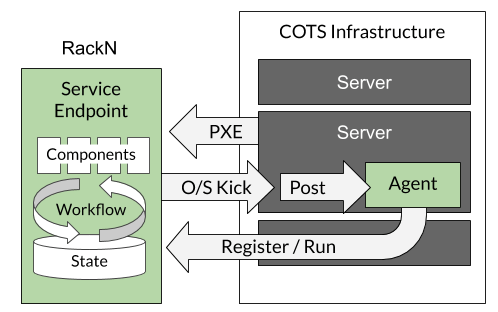This is part of an ongoing series where we explore some of the interesting things our new clients are up to.
About RackN
RackN’s mission is to help automate data centers by providing an integrated control plane for bare metal servers behind the firewall. The company was founded five years ago in fall of 2014, but members of the core team have been focusing on bare metal server management for nearly a decade.
Data centers are far from homogeneous environments – they run with a range of hardware, operating systems, and networking architectures, all provided by a range of vendors. These unique configurations can be difficult to manage at scale. RackN’s Digital Rebar Platform aims to provide a single point of management to help with provisioning across these disparate environments.
The platform runs using an agent architecture that is controlled via a persistent state engine in the data center. The platform also allows users to make changes at either the data center level or rack level, so users can have regional federated control and global visibility along with finer-grained control. It allows for multi-site management.
RackN allows users to express the desired state for their infrastructure through code. While RackN largely avoids describing itself via categories like “Software-Defined Data Center”, it’s a useful starting point to understanding the value proposition of the platform. The category that the company most leans into is “Infrastructure as Code,” or helping enterprises build and maintain their data centers from source code.
Business Model
RackN is a licensed software solution, not a SaaS offering or managed service provider. The platform can be run with no firewall connection and without granting network access, and the customer installs and manages the software themselves. No new data center hardware is required.
RackN focuses on dedicated infrastructure ranging from the on-premises data center, co-located data centers, and some edge infrastructure (e.g. racks in retail stores). In a world where it feels like nearly every vendor is telling a hybrid or multi-cloud story, it’s notable that RackN is staying away from that market for the time being; they are explicitly not targeting hybrid or multi-cloud solutions and are instead a purely behind the firewall play.
RackN began with an open core model, but updated the licensing of their latest release. The team found that with the previous model they struggled to find the right balance of what to open in the community version vs. what to keep proprietary. The new license terms keeps the platform API and content catalog open and continues to offer a free tier, but now requires a commercial software license to run the newest iteration of the platform.
The company is founder-majority owned.
I've been unlearning the VC "go big or go away" myth of success and feeling much better about @rackngo growing based on revenue, customer deliveries, anti-hype marketing and respect. It's not loud, but it's real.
— Rob Hirschfeld (@zehicle) May 29, 2019
Competitive Landscape
The majority of the new infrastructure investments made by enterprises today lean towards cloud, but there are still massive amounts of legacy investment to address within the data center. Much of RackN’s competitive differentiation comes from 1) focusing on bare metal 2) in the data center and 3) in a heterogeneous, multi-vendor environment.
One clear competitive set is other bare metal as a service (BMaaS) offerings, like Open Stack’s Ironic, Canonical Metal as a Service (MaaS), Cobbler, and Foreman. However, boundaries between markets are less clearly defined than they used to be, so there are several additional potential angles of competition for RackN.
- VMware is the most obvious leviathan vendor in the data center space, but does not focus on bare metal as directly as RackN. RackN views VMware as a partner.
- Similarly, various infrastructure as code / provisioning tools like Terraform, Chef, Puppet, Ansible, and SaltStack help users automate their software provisioning. These tools work in adjacent capacities to RackN. These tools rely on programmable API, which bare metal is notably lacking. RackN helps provide an integration point so automation and provisioning tools work against bare metal. (In theory, RackN could extend to replace some of these tools’ primary use cases, but for now RackN sees their toolset as complementary rather than as replacements.)
- Amazon Outposts is similar in terms of offering a fully integrated control plane within the data center, but their boxes are vendor managed. RackN is tackling the space from a self-managed, operator-controlled, multi-vendor perspective.
RackN provides an integrated control plane behind the firewall. It helps roll point solution tools in the data center into an integrated workflow.
Disclaimer: RackN is a RedMonk client, but this is not a commissioned piece of research and they had no editorial control over the content. AWS, Hashicorp (Terraform), and VMware are also RedMonk clients. Canonical, Chef, Open Stack Foundation, Puppet, and SaltStack are not current RedMonk clients.

No Comments